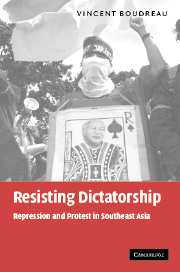Book contents
- Frontmatter
- Contents
- List of maps
- Acknowledgments
- List of abbreviations
- 1 Introduction
- 2 Protest, repression and transition in Southeast Asia
- 3 Authoritarian attack and dictatorial rise
- 4 Protest in socialist Burma
- 5 New Order repression and the Indonesian opposition
- 6 The Philippine new society and state repression
- 7 Repression and protest in comparative perspective
- 8 People power and insurgency in the Philippine transition
- 9 Protest and the underground in Burma
- 10 Indonesia's democracy protests
- 11 Democracy protest and state repression
- List of references
- Index
6 - The Philippine new society and state repression
Published online by Cambridge University Press: 15 December 2009
- Frontmatter
- Contents
- List of maps
- Acknowledgments
- List of abbreviations
- 1 Introduction
- 2 Protest, repression and transition in Southeast Asia
- 3 Authoritarian attack and dictatorial rise
- 4 Protest in socialist Burma
- 5 New Order repression and the Indonesian opposition
- 6 The Philippine new society and state repression
- 7 Repression and protest in comparative perspective
- 8 People power and insurgency in the Philippine transition
- 9 Protest and the underground in Burma
- 10 Indonesia's democracy protests
- 11 Democracy protest and state repression
- List of references
- Index
Summary
Earlier, I argued that Marcos's distracted authoritarian crackdown demonstrated more interest in state building than in defeating adversaries. In fact, Marcos detained many political rivals (i.e. excluding activists) for only a few months after martial law's onset. In late 1972, as the draft martial law constitution approached its referendum, he even released some prominent dissidents and encouraged them to debate the new document. They mounted so strong a campaign that Marcos canceled the vote, and rammed the constitution through an impromptu local assembly (barangay) approval process. Yet why allow the campaign at all? Neither Suharto nor Ne Win would seriously have tried conciliating such adversaries, nor have been surprised (as Marcos apparently was) at staunch resistance. Marcos, however, rose through a world of bounded political struggle, where electoral losers quickly accommodated themselves to victors – and he perhaps too readily expected support from those he jailed. He also expected all elites to support his regime, particularly if the alternative seemed communist revolution. Indeed, martial law's anti-communism might have attracted elite oppositionists like the Lopez or Aquino families – but in 1972 Philippine communism was still fairly ephemeral, without deep national roots, so intra-elite conflicts seemed far more pressing than any between the ruling class and insurgents. Accordingly, many elites were less inclined to accept martial law than Marcos expected, and authorities never devoted themselves to eradicating the communists they pretended so to fear.
- Type
- Chapter
- Information
- Resisting DictatorshipRepression and Protest in Southeast Asia, pp. 134 - 151Publisher: Cambridge University PressPrint publication year: 2004



